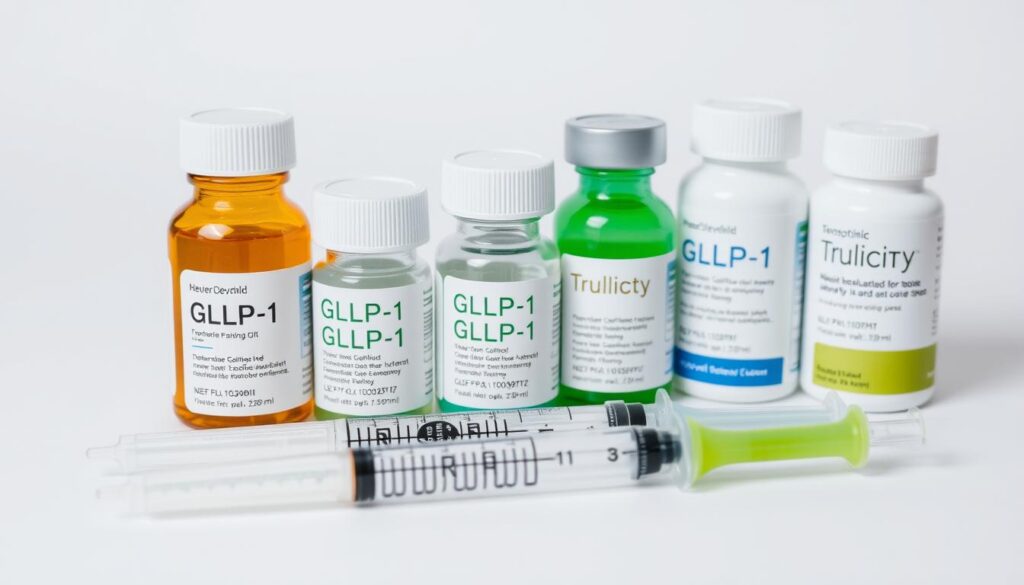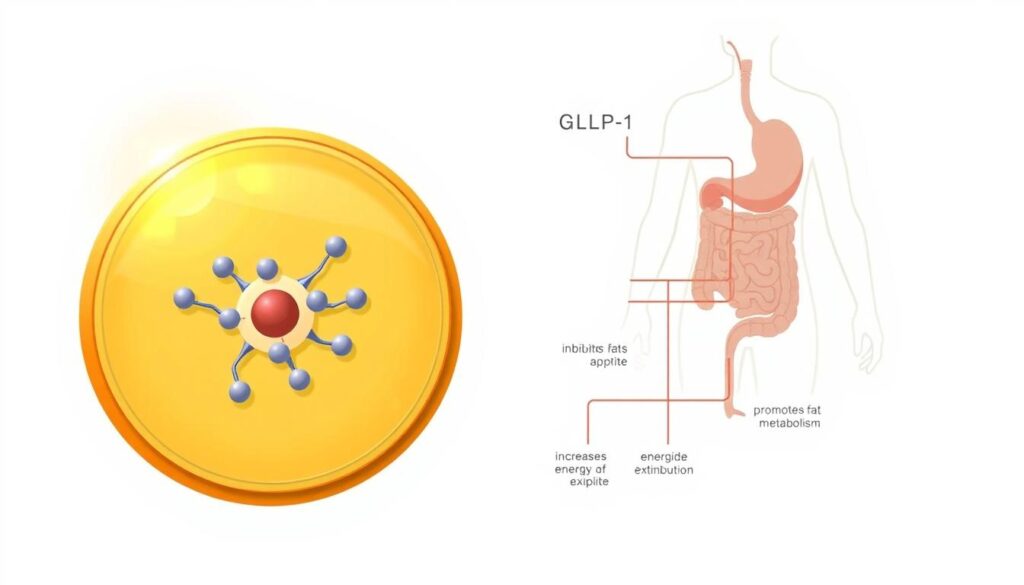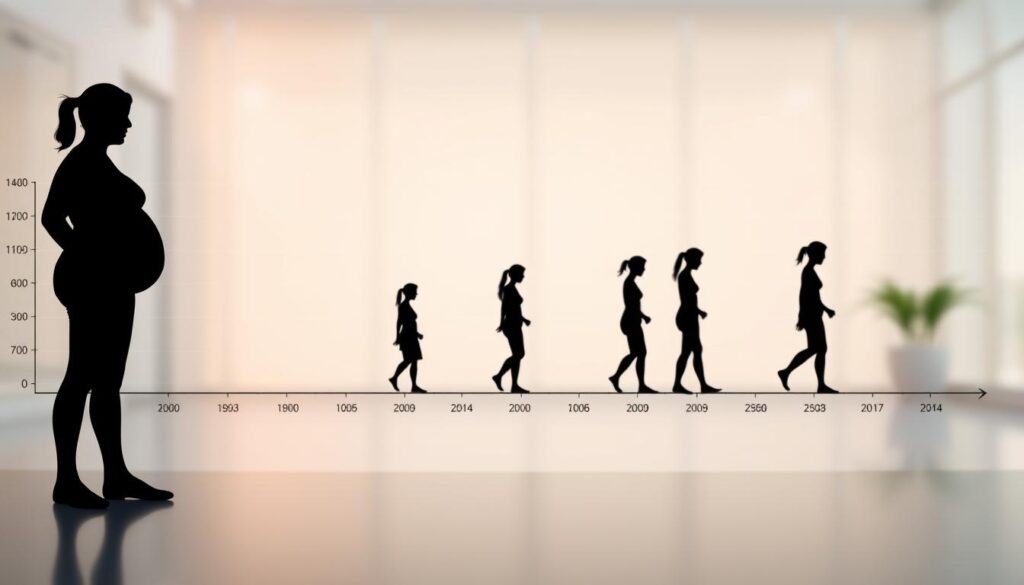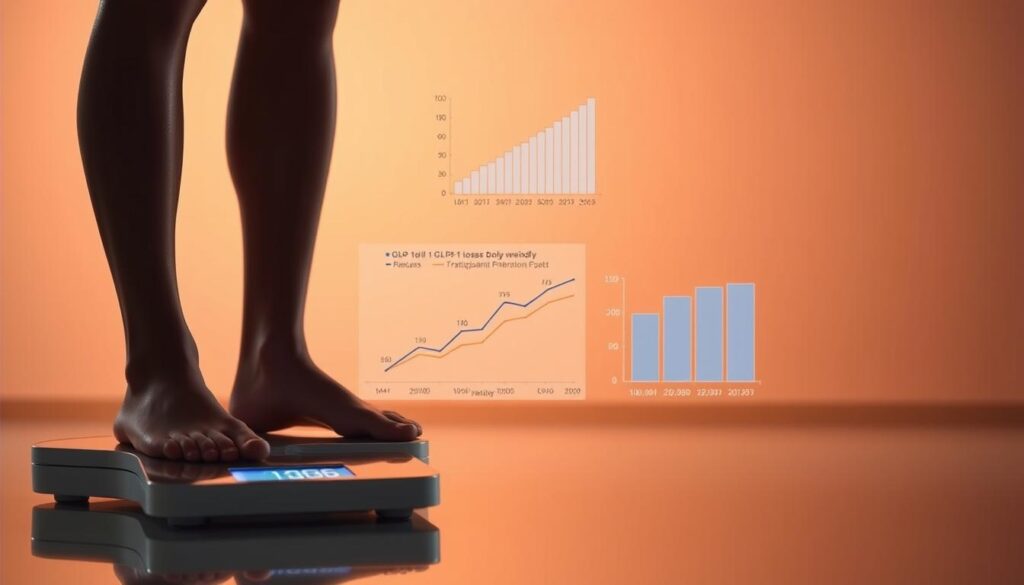GLP-1 receptor agonists have gained significant attention for their effectiveness in weight management. Medications like semaglutide (Wegovy) and tirzepatide (Zepbound) have been shown to help regulate appetite and improve metabolic health in clinical trials.
The growing interest in these medications is driven by their potential to support significant weight loss. As a result, many individuals are seeking to understand the effectiveness of GLP-1 medications and the rate at which they can expect to lose weight.
Key Takeaways
- GLP-1 receptor agonists are effective for weight loss.
- Medications like semaglutide and tirzepatide regulate appetite and improve metabolic health.
- Clinical trials have shown significant weight loss with GLP-1 medications.
- GLP-1 receptor agonists are gaining popularity for weight management.
- Understanding the effectiveness of GLP-1 medications is crucial for individuals seeking weight loss.
Understanding GLP-1 Medications for Weight Loss
GLP-1 medications, originally developed for type 2 diabetes, have shown remarkable efficacy in weight loss. These medications work by mimicking the action of a natural hormone in the body that helps regulate blood sugar levels and appetite.
What Are GLP-1 Receptor Agonists?
GLP-1 receptor agonists are a class of drugs that activate the GLP-1 receptor, enhancing the body’s natural response to the GLP-1 hormone. This activation leads to increased insulin secretion, decreased glucagon secretion, and delayed gastric emptying, all of which contribute to weight loss.
FDA-Approved GLP-1 Medications for Weight Management
The FDA has approved several GLP-1 medications for weight management, including semaglutide (Wegovy, Ozempic) and tirzepatide (Zepbound, Mounjaro). These medications have undergone rigorous clinical trials demonstrating their safety and efficacy in promoting significant weight loss.
The Difference Between Diabetes and Weight Loss Formulations
While some GLP-1 medications are approved for both diabetes and weight loss, the formulations and dosages may differ. For instance, semaglutide is marketed as Ozempic for diabetes management and Wegovy for weight loss, with the latter having a higher dosage. Understanding these differences is crucial for safe and effective treatment.

The Science Behind GLP-1 and Weight Loss
GLP-1 receptor agonists have revolutionized the approach to weight loss by leveraging the body’s natural mechanisms to reduce hunger and increase feelings of fullness. These medications mimic the action of the naturally occurring hormone GLP-1 (Glucagon-Like Peptide-1), which plays a crucial role in regulating appetite, glucose metabolism, and energy balance.
How GLP-1 Affects Appetite and Satiety
GLP-1 receptor agonists suppress appetite by acting on the brain’s appetite centers, making individuals feel less hungry and more satisfied with smaller portions. This effect is partly due to the slowing of gastric emptying, which keeps food in the stomach for longer, thereby prolonging the feeling of fullness.

Impact on Gastric Emptying
The slowing of gastric emptying is a key mechanism by which GLP-1 medications contribute to weight loss. By delaying the movement of food from the stomach to the small intestine, these medications help to reduce postprandial glucose peaks and prolong the feeling of satiety.
Metabolic Effects of GLP-1 Medications
GLP-1 receptor agonists also have beneficial effects on metabolism, including improved insulin sensitivity and glucose-dependent insulin secretion. These effects contribute to better glycemic control and can lead to weight loss.
| Effect | Description | Benefit |
|---|---|---|
| Appetite Suppression | Acts on brain’s appetite centers | Reduced hunger |
| Gastric Emptying | Delays food movement to small intestine | Prolonged satiety |
| Metabolic Effects | Improves insulin sensitivity and secretion | Better glycemic control and weight loss |
By understanding these mechanisms, individuals can better appreciate how GLP-1 medications facilitate significant weight loss, making them a valuable tool in the management of obesity.
How Fast Do You Lose Weight on GLP-1?
Understanding the timeline for weight loss on GLP-1 is crucial for setting realistic expectations. GLP-1 medications have been shown to facilitate substantial weight loss, but the rate can vary from person to person.
Initial Weight Loss Timeline
Clinical trials have demonstrated that patients on GLP-1 medications can experience significant weight loss within the first few months. For instance, studies on semaglutide and tirzepatide have shown noticeable weight loss as early as the first month.
Average Weekly and Monthly Weight Loss Rates
On average, patients can expect to lose between 1-2 pounds per week on GLP-1 medications, though this rate can vary. Over a month, this translates to a 4-8% reduction in body weight, which is significant for many individuals.

Plateaus and Long-Term Results
While initial weight loss can be rapid, some patients may experience plateaus as their body adapts to the medication. Long-term results show that sustained weight loss is possible with continued use of GLP-1 medications and lifestyle modifications.
| Timeframe | Average Weight Loss |
|---|---|
| 1 Month | 4-6% |
| 3 Months | 8-12% |
| 6 Months | 15-20% |
In conclusion, the rate of weight loss on GLP-1 medications can be significant, especially in the initial months. Understanding the potential timeline and factors influencing weight loss can help individuals set realistic goals and maximize their results.
Semaglutide (Wegovy, Ozempic) Weight Loss Timeline
For those considering GLP-1 medications for weight loss, understanding the semaglutide weight loss timeline is crucial. Semaglutide, marketed under the brand names Wegovy and Ozempic, has been studied extensively for its efficacy in weight management.
First Month Results
In the initial month, patients typically start noticing weight loss due to semaglutide’s effect on reducing appetite and improving satiety. Studies indicate that a significant portion of the weight loss occurs in the first few months of treatment.
Three-Month Milestone
By the three-month mark, clinical trial data shows that patients have lost around 5% of their initial body weight. This is a significant milestone, indicating the medication’s effectiveness.
Six-Month and One-Year Outcomes
Continuing beyond three months, semaglutide users can expect to lose up to 15-20% of their body weight by one year. This weight loss trajectory underscores the potential of semaglutide for long-term weight management.
Clinical Trial Data
- Significant weight loss observed in clinical trials, with averages ranging from 5% to 20% over the course of a year.
- Participants following a GLP-1 diet plan for fast weight loss saw enhanced results.
Real Patient Experiences
Real patient testimonials often highlight the rapid initial weight loss and the medication’s impact on their overall health and well-being. 
It’s essential to note that individual results may vary, and factors such as starting BMI, lifestyle modifications, and concurrent health conditions can influence the weight loss timeline.
Tirzepatide (Mounjaro, Zepbound) Weight Loss Speed
Tirzepatide, a dual GIP/GLP-1 receptor agonist, has shown considerable promise in clinical trials for its weight loss effects. As a relatively new medication, its weight loss speed is of particular interest to both healthcare providers and patients.
Expected Weight Loss by Week
Clinical trials have indicated that tirzepatide can lead to significant weight loss. Patients can expect a gradual reduction in weight over several weeks. The rate of weight loss tends to be more pronounced in the initial weeks.
Comparison to Semaglutide Timeline
When comparing tirzepatide to semaglutide, another popular GLP-1 receptor agonist, studies suggest that tirzepatide may offer a slightly faster weight loss trajectory. For more information on semaglutide’s weight loss timeline, you can refer to our detailed analysis on GLP-1 agonists like Mounjaro or Wegovy.
Clinical Trial Results and Timelines
The SURMOUNT trial, a significant clinical study on tirzepatide, has provided valuable insights into its weight loss potential.
SURMOUNT Trial Findings
The SURMOUNT trial demonstrated that participants receiving tirzepatide experienced substantial weight loss, with results showing:
- Average weight loss ranging from 15% to 20% of initial body weight over 72 weeks.
- Significant improvements in various metabolic parameters.
Patient Success Stories
Many patients have reported successful weight loss journeys with tirzepatide. While individual results vary, the medication has been praised for its efficacy in supporting weight loss efforts.

In conclusion, tirzepatide represents a promising option for weight loss, with clinical trial data supporting its effectiveness. As with any medication, it’s essential to consult with a healthcare provider to determine if tirzepatide is the right choice for your weight loss journey.
Liraglutide (Saxenda) Weight Loss Progression
Liraglutide, known by its brand name Saxenda, is a GLP-1 receptor agonist that has been shown to be effective for weight loss. It works by mimicking a natural hormone that helps regulate appetite and food intake, leading to significant weight reduction in many patients.
Initial Response Period
When starting liraglutide, patients often experience an initial response within the first few weeks. This early response can include reduced hunger and increased feelings of fullness. Studies have shown that within the first month, many patients begin to notice weight loss.
Long-Term Weight Loss Expectations
Long-term weight loss expectations with liraglutide are promising. Clinical trials have demonstrated that patients can achieve significant weight loss over several months. On average, patients can expect to lose a substantial percentage of their initial body weight within the first year of treatment.
Maintenance Phase Timeline
The maintenance phase is crucial for sustaining weight loss over time. Liraglutide has been shown to help patients maintain their weight loss throughout the treatment period. Regular check-ins with healthcare providers are essential during this phase to monitor progress and adjust treatment as needed.
Weight Loss Progression with Liraglutide:
| Timeframe | Average Weight Loss |
|---|---|
| First Month | 5-10% of initial body weight |
| 3 Months | 10-15% of initial body weight |
| 6 Months | 15-20% of initial body weight |
| 1 Year | 20-25% of initial body weight |

In conclusion, liraglutide (Saxenda) offers a viable option for individuals seeking to lose weight. By understanding the initial response period, long-term weight loss expectations, and maintenance phase timeline, patients can better navigate their weight loss journey with this medication.
Factors Affecting GLP-1 Weight Loss Speed
GLP-1 medications have been shown to facilitate weight loss, but the rate of this loss is affected by various individual factors. Understanding these factors can help individuals better manage their expectations and optimize their weight loss journey.
Starting BMI and Body Composition
The initial body mass index (BMI) and body composition play a significant role in determining the speed of weight loss on GLP-1 medications. Individuals with a higher starting BMI may experience more rapid weight loss initially.
Dosage and Titration Schedule
The dosage and titration schedule of GLP-1 medications can significantly impact weight loss speed. A study on GLP-1 for diabetes management showed that proper dosing is crucial for effectiveness.

Concurrent Lifestyle Modifications
Lifestyle changes, including diet and exercise, can enhance the weight loss effects of GLP-1 medications. Combining these medications with healthy habits can lead to more significant weight loss.
Individual Metabolic Factors
Metabolic factors, such as insulin sensitivity and metabolic rate, vary among individuals and can influence the effectiveness of GLP-1 for weight loss.
| Factor | Impact on Weight Loss |
|---|---|
| Starting BMI | Higher BMI may result in faster initial weight loss |
| Dosage and Titration | Proper dosing enhances weight loss effectiveness |
| Lifestyle Modifications | Diet and exercise can significantly enhance weight loss |
| Metabolic Factors | Individual metabolic differences affect weight loss speed |
By understanding these factors, individuals can better navigate their weight loss journey on GLP-1 medications, setting realistic expectations and making informed decisions about their treatment plan.
Real User Experiences with GLP-1 Weight Loss
Real users have shared their diverse experiences with GLP-1 weight loss medications, providing valuable insights into the effectiveness of these treatments. The range of outcomes is broad, from rapid weight loss to more gradual results.
Testimonials from Rapid Responders
Some individuals have reported significant weight loss within the first few weeks of starting GLP-1 therapy. For example, Sarah, a 35-year-old woman, lost 15 pounds in the first month after starting semaglutide injections. Rapid responders often attribute their success to a combination of the medication and lifestyle changes, such as improved diet and increased physical activity.
Stories from Average-Pace Weight Loss Patients
Many users experience a more gradual weight loss, which can be just as motivating. Mark, a 42-year-old man, lost 10% of his body weight over three months while taking liraglutide. Consistency and patience are key for these individuals, as they work towards their weight loss goals.
Lessons from Those with Slower Results
For some, weight loss may be slower, but still significant in the long term. Emily, a 28-year-old woman, experienced a slower weight loss rate on tirzepatide, but she continued to lose weight steadily over six months. Persistence and adjustments to treatment plans can make a significant difference for those with slower initial results.
These real-life experiences highlight the variability in GLP-1 weight loss results and underscore the importance of personalized treatment approaches.

Setting Realistic Expectations for GLP-1 Weight Loss
Understanding the pace of weight loss with GLP-1 medications is crucial for setting realistic expectations. GLP-1 receptor agonists have shown significant promise in clinical trials for weight management, but real-world results can vary.
What Clinical Trials Show vs. Real-World Results
Clinical trials provide a controlled environment that may not accurately represent individual experiences. For instance, a GLP-1 weight loss guide might highlight average weight loss figures that are not reflective of everyone’s journey. Real-world results can be influenced by factors such as adherence to medication, diet, and exercise habits.

Individual Variation in Response
It’s essential to recognize that people respond differently to GLP-1 medications. Factors such as starting BMI, dosage, and individual metabolic factors can influence the rate of weight loss. Some may experience rapid weight loss, while others may see more gradual results.
- Starting BMI: Individuals with a higher BMI may experience more significant weight loss initially.
- Dosage and Titration: The rate at which the dosage is increased can impact the speed of weight loss.
- Lifestyle Factors: Diet and exercise play a crucial role in enhancing the effectiveness of GLP-1 medications.
The Importance of Patience and Consistency
Patience and consistency are key when using GLP-1 medications for weight loss. It’s crucial to follow the prescribed treatment plan and make necessary lifestyle adjustments to support your weight loss journey. Regular check-ins with healthcare providers can help in making adjustments and staying on track.
By understanding these factors and maintaining realistic expectations, individuals can better navigate their GLP-1 weight loss journey and achieve more sustainable results.
Maximizing Weight Loss Results with GLP-1
Maximizing weight loss with GLP-1 receptor agonists requires a comprehensive approach that includes diet, exercise, and stress management. By combining these medications with healthy lifestyle choices, individuals can enhance their weight loss results and improve overall health.
Dietary Recommendations While Taking GLP-1
A well-balanced diet is crucial when taking GLP-1 medications for weight loss. Focus on consuming nutrient-dense foods such as fruits, vegetables, lean proteins, and whole grains. It’s also important to limit processed foods and those high in sugar and saturated fats.
A glp 1 diet plan for fast weight loss should include a variety of foods to ensure you’re getting all the necessary nutrients. Consider the following dietary tips:
- Choose lean protein sources like poultry, fish, and legumes.
- Incorporate a range of colorful vegetables to maximize nutrient intake.
- Opt for whole grains over refined carbohydrates.
- Stay hydrated by drinking plenty of water throughout the day.
Exercise Guidelines for Enhanced Results
Regular physical activity is essential for maximizing weight loss with GLP-1. Aim for at least 150 minutes of moderate-intensity exercise or 75 minutes of vigorous-intensity exercise per week. This can include activities such as brisk walking, cycling, or swimming.
In addition to aerobic exercise, incorporating strength training into your routine can help build muscle mass and boost metabolism. Consider the following exercise tips:
- Start with low-impact exercises if you’re new to physical activity.
- Gradually increase the intensity and duration of your workouts.
- Incorporate strength training exercises at least twice a week.
Sleep and Stress Management
Adequate sleep and effective stress management are also critical components of a successful weight loss plan. Poor sleep can disrupt hormones that regulate hunger and fullness, while chronic stress can lead to emotional eating and weight gain.
To improve sleep, establish a consistent bedtime routine and create a sleep-conducive environment. For stress management, consider techniques such as meditation, deep breathing, or yoga. These practices can help reduce stress and promote overall well-being.
By combining GLP-1 medications with a healthy diet, regular exercise, and effective stress management, individuals can maximize their weight loss results and achieve a healthier, more sustainable lifestyle.
Medical Supervision and Healthcare Provider Guidance
Medical supervision plays a crucial role in maximizing the benefits of GLP-1 weight loss therapy. Regular interactions with healthcare providers are essential for adjusting treatment plans and achieving optimal weight loss results.
The Importance of Regular Check-ins
Regular check-ins with healthcare providers allow for timely adjustments to treatment plans. These check-ins are vital for monitoring weight loss progress, addressing any side effects, and providing ongoing support and motivation.
- Monitoring weight loss progress
- Addressing any side effects
- Providing ongoing support and motivation
Adjusting Dosage for Optimal Results
Dosage adjustments are often necessary to achieve the best weight loss results. Healthcare providers can increase dosage to enhance weight loss, decrease dosage to manage side effects, or switch to a different GLP-1 medication if needed.
When to Consider Switching Medications
If weight loss plateaus or side effects become unmanageable, it may be necessary to consider switching to a different GLP-1 medication. Healthcare providers can help determine the best course of action based on individual patient needs.
Potential Side Effects That May Impact Weight Loss Progress
Shedding pounds with GLP-1 medications can be a highly effective strategy, but it’s not without potential side effects that need to be managed. GLP-1 receptor agonists have been shown to cause various side effects, some of which can impact weight loss progress.
Common Gastrointestinal Side Effects
One of the most common categories of side effects associated with GLP-1 medications are gastrointestinal issues. These can include nausea, vomiting, diarrhea, and constipation. Such side effects can be uncomfortable and, in some cases, may affect a person’s ability to maintain the medication regimen.
Managing Nausea and Reduced Appetite
Nausea is a prevalent side effect, particularly when first starting GLP-1 medications. Managing nausea is crucial, as it can impact eating habits and overall nutrition. Strategies to mitigate nausea include eating smaller, more frequent meals and avoiding foods that trigger discomfort.
When Side Effects May Slow Weight Loss
In some cases, side effects like persistent nausea or gastrointestinal issues can lead to reduced caloric intake, potentially slowing weight loss. It’s essential to work closely with a healthcare provider to adjust the treatment plan if side effects are impacting weight loss progress.
| Side Effect | Management Strategy |
|---|---|
| Nausea | Eating smaller meals, avoiding trigger foods |
| Gastrointestinal issues | Dietary adjustments, hydration |
| Reduced appetite | Consulting with a healthcare provider, nutritional counseling |
Who Should Avoid GLP-1 Medications
Not everyone is a candidate for GLP-1 medications, particularly those with specific health conditions. While these medications can be highly effective for weight loss, certain individuals may face increased risks or adverse reactions.
Medical Contraindications
GLP-1 receptor agonists are contraindicated in patients with a personal or family history of medullary thyroid carcinoma (MTC) and in those with Multiple Endocrine Neoplasia syndrome type 2 (MEN 2). Individuals with a history of pancreatitis should also exercise caution, as GLP-1 medications may increase the risk of pancreatitis.
Risk Factors for Adverse Reactions
Patients with severe gastrointestinal disease, such as gastroparesis, should avoid GLP-1 medications due to the potential for exacerbating these conditions. Additionally, those with kidney disease or a history of acute kidney injury should be monitored closely.
Alternative Options for Ineligible Patients
For individuals who cannot use GLP-1 medications, other weight loss options are available, including different pharmacological treatments and lifestyle interventions. Consulting with a healthcare provider can help determine the most suitable alternative based on individual health status and weight loss goals.
GLP-1 Weight Loss Compared to Other Methods
GLP-1 receptor agonists have emerged as a significant player in the weight loss landscape, offering a unique approach compared to traditional methods. As individuals seek effective weight loss solutions, understanding how GLP-1 medications compare to other strategies is crucial.
Diet and Exercise
Traditional diet and exercise are foundational elements of weight loss. However, GLP-1 medications can enhance these efforts by:
- Reducing hunger and increasing feelings of fullness
- Slowing gastric emptying to reduce postprandial blood sugar spikes
- Improving metabolic health
Studies have shown that combining GLP-1 medications with diet and exercise can lead to significant weight loss, often exceeding the results achieved through lifestyle modifications alone.
Other Weight Loss Medications
Compared to other weight loss medications, GLP-1 receptor agonists offer a distinct mechanism of action. Key differences include:
- Superior weight loss efficacy in many cases
- A favorable safety profile when used under medical supervision
For instance, a comparison of GLP-1 vs. other weight loss medications reveals that GLP-1 agonists often result in more substantial weight loss.
Bariatric Surgery
Bariatric surgery is a highly effective weight loss method, particularly for individuals with severe obesity. While GLP-1 medications may not match the weight loss achieved through surgery, they offer a less invasive alternative with fewer risks.
Ultimately, the choice between GLP-1 medications, traditional weight loss methods, other medications, or bariatric surgery depends on individual health needs and goals. Consulting with a healthcare provider is essential to determine the most appropriate weight loss strategy.
Monitoring Your GLP-1 Weight Loss Journey
As you embark on your GLP-1 weight loss journey, monitoring your progress is crucial for achieving your goals. Effective tracking helps you understand how your body is responding to the medication and allows you to make necessary adjustments to your lifestyle.
Tracking Tools and Methods
Utilizing the right tools can make a significant difference in monitoring your progress. Digital apps and physical journals are popular methods for tracking weight loss. These tools allow you to record your daily food intake, exercise, and weight, providing a comprehensive view of your journey.
Important Metrics Beyond the Scale
While weight is an important metric, it’s not the only indicator of progress. Body measurements, energy levels, and overall well-being are also crucial. These metrics can provide a more nuanced understanding of your progress, highlighting improvements that may not be reflected on the scale.
When to Expect Visible Changes
Visible changes can occur at different times for different individuals. Generally, noticeable weight loss becomes apparent within the first few months of starting GLP-1 treatment. As one user noted,
‘I started noticing significant changes in my body after 12 weeks on GLP-1. My clothes were fitting better, and I had more energy.’
Conclusion: Is GLP-1 Right for Your Weight Loss Timeline?
GLP-1 medications have emerged as a promising solution for weight loss, offering significant results for many individuals. The speed at which you lose weight on GLP-1 depends on various factors, including your starting BMI, dosage, and lifestyle modifications.
When considering GLP-1 medications, it’s essential to understand their effectiveness and potential side effects. Clinical trials have shown that medications like semaglutide and tirzepatide can lead to substantial weight loss, with some individuals experiencing rapid results.
To determine if GLP-1 is right for your weight loss timeline, consult with a healthcare provider to discuss your individual needs and health conditions. They can help you weigh the benefits and risks, ensuring you make an informed decision about your weight loss journey.
By understanding how fast you can lose weight on GLP-1 and the medication’s overall effectiveness, you can set realistic expectations and achieve your weight loss goals.


